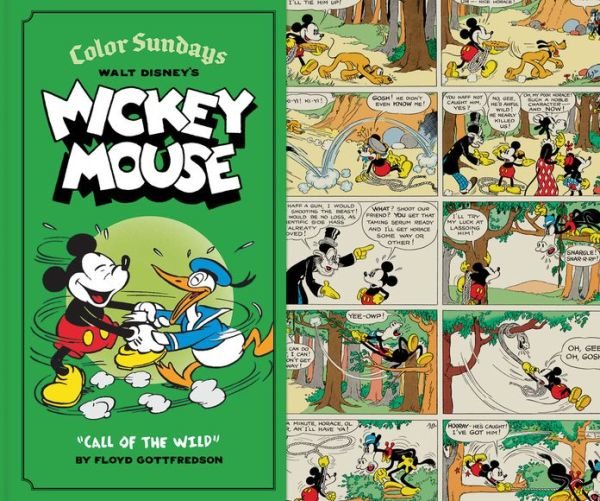
Review: Walt Disney’s Mickey Mouse Color Sundays: “Call of the Wild”
 Walt Disney’s Mickey Mouse Color Sundays: “Call of the Wild”
Walt Disney’s Mickey Mouse Color Sundays: “Call of the Wild”
By Floyd Gottfredson
Fantagraphics, $29.99
Running parallel to their complete collection of the daily comic strips of Floyd Gottfredson, who is to Mickey Mouse as Carl Barks is to Donald Duck, Fantagraphics is now collecting Gottfredson’s color Sunday strips, and this is the first of the two collections so far available.
Those in this volume were produced and originally published between 1932 and 1935, and, at this very early period in Mickey Mouse history, the character, his cast, his milieu, and even the tone of his adventures is still very much under development; reading 1930s Mickey comics in 2013 feels something like paleontology, examining previous incarnations of an evolutionary success story and marveling at what’s changed, how it’s changed, and what’s remained the same.
ADVERTISEMENT
ADVERTISEMENT
In this collection, the original Mickey, Minnie, Horace Horsecollar, Clarabelle Cow, and Petgleg Pete cast begins expanding with Mickey’s hellion nephews, a not-very-bright dog named Dippy (who would eventually become Goofy), and an import from the animated cartoons, one Donald Duck.
As in the black-and-white collections, it’s a thrill to see how the characters have changed, in their temperaments, relationships and portrayals, with Mickey’s later besties Dippy/Goofy and Donald seeming a bit more like intruders here.
Donald, whose popularity eventually eclipsed Mickey’s at least among comics lovers, in particular has changed significantly, appearing here significantly smaller than Mickey, and with a long, long bill and more elongated, duck-like neck.
These comics being in color, we also get to witness the evolution of the character’s coloring, with Mickey and Minnie sometimes having flesh-colored faces, but generally having white ones. Pluto is occasionally white or dark brown but usually appears in his regular orange-ish cast. As for Donald, he’s generally yellow, and, on one occasion, has black legs.
Color’s not the only significant difference between the Sundays and the dailies, of course. The greater length of these allows for thorough, thought-out, and elaborately performed gag strips, each three or four times longer than the daily strips. There are several ongoing adventure features as well, with notable ones including Mickey and the gang taking trips out west, out into the wild to go camping, and up a mountain, where they encounter Old West-style outlaws, a strange serum that turns civilized humans into wild animals (or, in this case, anthropomorphic horses into wild animals), and, of course, the elements.
Another long-form adventure involves Mickey training a pet kangaroo to box Pegleg Pete’s pet gorilla, an action-packed storyline that demonstrates Gottfredson’s fluid, kinetic cartooning perfectly—passages of it read as so animated, they might as well be projected on a movie screen.
ADVERTISEMENT
ADVERTISEMENT
The length of the individual installments means that in the Sundays, Gottfredson is able to avoid the often staccato stopping and starting of the daily strips, a great weakness of the latter form that can make reading them a bit more difficult, at least until the reader can establish a rhythm.
It also means that this particular collection is probably a better place for casual and younger readers to start. This Mickey is still a lot different than the one appearing on, say, Mickey Mouse Clubhouse, as he and Donald handle guns, and it’s difficult to imagine a 21st century comic in which Mickey participates in an animal-on-animal fight for entertainment, but the adventures are generally less intense and less dangerous than those in the dailies.
Mickey’s still not quite as domesticated a mouse as he would eventually become, but for older readers, that will hardly be a problem. The copious amounts of supporting material, including essays and bits of art from various sources, attests to the true audience of the book—adult comics enthusiasts—but the charm of the strip, like Gottfredson’s skills, is timeless, and therefore ageless.
If you’re old enough to read on your own, then you’re probably old enough to read Mickey Mouse comics, even if you have to ask your parents why Mickey is using a camera with a tripod instead of just using his cell, or what the heck an ice box or an ashcan is.
Filed under: Reviews
About J. Caleb Mozzocco
J. Caleb Mozzocco is a way-too-busy freelance writer who has written about comics for online and print venues for a rather long time now. He currently contributes to Comic Book Resources' Robot 6 blog and ComicsAlliance, and maintains his own daily-ish blog at EveryDayIsLikeWednesday.blogspot.com. He lives in northeast Ohio, where he works as a circulation clerk at a public library by day.
ADVERTISEMENT
ADVERTISEMENT
SLJ Blog Network
2024 Books from Coretta Scott King Winners
Monster Befrienders and a Slew of Horror/Comedy: It’s a Blood City Rollers Q&A with V.P. Anderson & Tatiana Hill
Parsing Religion in Public Schools
ADVERTISEMENT








This is good stuff, indeed.
Mickey`s very similar to his original version, in modern comics. Modern, European comics, that is.
I’ve really been enjoying the new animated Mickey Mouse shorts. They’re very much a tribute to the early MM works. http://mickey.disney.com/mickey-cartoons.
Speak of European MM comics – anyone know of the best way to get them in the US? Such a shame we don’t have them here at all anymore.